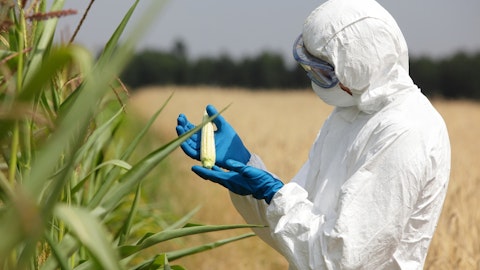It gives us time to be able to continue to collect data that is meaningful, differentiated, to understand where centers may be struggling, where else we can optimize our vein-to-vein profits to deliver a product that’s differentiated not just in efficacy and safety perhaps but also in our operational aspects. So we see the market developing in a very robust way. We just think it’s going to take a little bit of time. So we’re very pleased with initial interest, certainly the ongoing interest in our clinical studies and look forward to talking more with you about it.
Greg Harrison: Great. That’s helpful. Thanks so much.
Operator: Our next question comes from Mani Foroohar with Leerink. Please proceed with your question.
Mani Foroohar: Great. Thanks for taking the question. You talked a little bit about improvements in vein-to-vein time as an incremental source of differentiation and independent of clinical data. Can you walk through how you guys think of the timing on which we might see that show up in terms of CapEx investment, in terms of clinical trial execution, et cetera? Like where we’re going to start to see data points that could de-risk that part of your advantage in the eyes of investors?
Baisong Mei: Yes. Thanks for the question. This is Baisong. Thank you, Mani. We are in the clinical trial stage, right. We’re already trying to optimize all the process from vein-to-vein, as you mentioned. So we amend our protocol and work with our expert in free treats, for example, and to help with the sites in the free treat cycle and help with sites to prepare the patients and provide support. So that’s kind of the experience we gather now will help for our future commercial launch. I’ll pass that to Caren on that.
Caren Deardorf: Yes. And just to add, as we continue to be very engaged in our clinical sites and expanding our outreach to other centers, we’ll have the opportunity to really understand how the process is working, how we make the introduction and the products like reni-cel as seamless as possible, do the advanced work, fit into their existing processes. But we’re always looking at opportunities across just, again, the efficiency, the timing, and we’ll certainly be able to talk more as we get closer.
Mani Foroohar: Great. That’s helpful.
Operator: Our next question comes from Terence Flynn with Morgan Stanley. Please proceed with your question.
Max Skor: Great. Thank you, team. This is Max Skor on for Terrence Flynn. Can you provide an update on CRISPR-Cas9 appeal case and whether you expect an oral argument in the first half of 2024? Thank you.
Gilmore O’Neill: Thanks very much, Max. We have the Court of Appeals, Federal Circuit has yet to schedule that oral hearing. It should be sometime this year. And once we have that scheduling, we can update you on that.
Max Skor: Great. Thank you.
Operator: Our next question comes from Gena Wang with Barclays. Please proceed with your question.
Gena Wang: Thank you for taking my questions. So if I heard it correctly, Gilmore, you mentioned that the FDA and I think both of you may be mentioned single study, FDA agree on the single study, also number of a patient. I’m not sure if they agree on the duration of the study for RUBY trial. So wondering, if we think about the CRISPR trial, vertex trial, it’s about 45 to 50 patients. Is that aligned with that numbers? And what is the duration that FDA require? And related questions, how many active sites you have now? And what is your goal of total sites for the pivotal study?
Gilmore O’Neill: Thanks very much, Gina, for your question. Before I, let me just address a couple of things from the point of view of the study design. I think, first of all, the benchmark that was set by the BLA with Vertex approval by the FDA for exa-cel is actually very good benchmark against, which we’re operating. And that is certainly informed our discussions with the FDA. We were actually very pleased with the discussion with the FDA, and we believe that it actually really puts us on a track that lines up with the benchmark And as a result, when we actually talk about having enrolled our 40 patients, how we’ve initiated the adolescent enrollment and so on, we believe we’re actually on a very good track for – to BLA. With regard to the number of active sites, I actually want to clarify something.
We’re not talking about a separate study. Essentially, the RUBY study, which is ongoing with its sites activated, is the Phase 1, 2, 3 study. That will be used for BLA, and that is the agreement that we have with the agency.
Gena Wang: Okay. Sorry. The reason I’m asking more thinking about in the future commercial perspective, if you have already established the active sites for your clinical trial, and it’s very easy to transition this to commercial once drug-approved in the future?
Gilmore O’Neill: Yes, I understand that and appreciate that clarification. And certainly, we agree with that principle. I can take it, Caren, if you want to add to that.
Caren Deardorf: No, no. I mean I know we – had already expanded the number of sites previously to get to a number that would support the full study, right, based on. So that was a very thoughtful approach to ensure that we had a good, strong number of sites with geographic coverage.
Baisong Mei: Yes. Maybe I can add a bunch. We already share we have activated over 20 sites. And so we got over 20 sites who are already enrolled 40 patients. And we already, those sites for adolescent cohort that you have the overlap between the adult and adolescent from the same study sites. And we are also activating a few more sites that specifically for pediatric patients.
Gena Wang: Thank you very much.
Operator: Our next question comes from Dae Gon Ha with Stifel. Please proceed with your question.





